September 2010
Fully modular: Psion Teklogix Omnii XT10
 For a while now Psion-Teklogix has been concerned about offering their customers the exact right handheld computer for a given job. This resulted in the "Modulus" concept that modularizes their hardware platforms as much as possible. With their new full-size Omni XT10, the company is now offering a fully modular ultra-rugged handheld that adheres to the stated goal of offering flexibility, modularity and an open platform to their customers. [See description and specs of the Psion Teklogix Omnii XT10] -- Posted Thursday, September 30, 2010
For a while now Psion-Teklogix has been concerned about offering their customers the exact right handheld computer for a given job. This resulted in the "Modulus" concept that modularizes their hardware platforms as much as possible. With their new full-size Omni XT10, the company is now offering a fully modular ultra-rugged handheld that adheres to the stated goal of offering flexibility, modularity and an open platform to their customers. [See description and specs of the Psion Teklogix Omnii XT10] -- Posted Thursday, September 30, 2010
95% of all email junk and spam now
According to PandaLabs, 95% of all email circulated across the Internet during the last quarter was junk mail and approximately 50% of all spam was sent from just ten countries, with India, Brazil and Russia as the top three originators. One wonders how long a system that generates mostly junk and threats can be sustained. -- Posted Thursday, September 30, 2010
The Intermec CS40 Mobile Computer
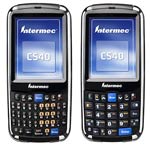 If you feel iPhones and such are nice, but not quite rugged enough and they don't really fit into your corporate enterprise systems, Intermec has a device for you. It's the new CS40 that's small and handy enough to fit into any pocket, has an industrial-strength 1D/2D scanning engine, 3.75G WWAN, a QWERTY or a phone key layout, Windows Mobile 6.5, and the kind of ruggedness and longevity that consumer phones just can't match. [See description and specs of the Intermec CS40] -- Posted Wednesday, September 29, 2010
If you feel iPhones and such are nice, but not quite rugged enough and they don't really fit into your corporate enterprise systems, Intermec has a device for you. It's the new CS40 that's small and handy enough to fit into any pocket, has an industrial-strength 1D/2D scanning engine, 3.75G WWAN, a QWERTY or a phone key layout, Windows Mobile 6.5, and the kind of ruggedness and longevity that consumer phones just can't match. [See description and specs of the Intermec CS40] -- Posted Wednesday, September 29, 2010
BlackBerry Playbook tablet
At their BlackBerry Developer's Conference, RIM president Mike Lazaridis showed off the BlackBerry Playbook, a tablet with a 7-inch 1024 x 600 pixel capacitive multi-touch display, a 1GHz processor, a gig of RAM, WiFi and Bluetooth (with 3/4G in the future), and a design (very) reminiscent of the iPad. The 5.1 x 7.6 x 0.4-inch tablet will weigh less than a pound and run a BlackBerry tablet OS. It'll be available early 2011. -- Posted Tuesday, September 28, 2010
GPS increasingly becoming a standard feature
According to a new research report by Berg Insight, global shipments of GPS-enabled GSM/WCDMA handsets increased 92% in 2009 to 150 million units. More and more, GPS is becoming a standard feature on new smartphones and handhelds, making GPS related applications from mapping, to GIS functionality and numerous other apps (check out Berry tracking!) possible and almost mandatory. -- Posted Tuesday, September 28, 2010
Getac B300 gets substantial technology, features, ruggedness update
Getac announced a substantial technology, feature, and ruggedness update to the Getac B300. On the technology side, the new B300 uses a 2GHz Intel Core i7 processor, more and faster RAM, larger hard disks and the availability of optional SSDs, an optional display that is even brighter than before (1400 nits!), better sealing and a wider operating temperature range, faster and more extensive wireless communication support, as well as faster graphics and an HDMI port. RuggedPCReview.com will conduct a full evaluation and run full benchmarks as soon as an eval B300 becomes available. -- Posted Tuesday, September 21, 2010
Motorola releases fast, tough MC65 EDA with dual 3.5G WWAN
 Motorola released the MC65 enterprise digital assistant. It's an ultra-rugged (6-foot drop, IP65 sealing) handheld that combines advanced data capture via a Symbol SE4500 1D/2D imager, PDA functionality, with software-configurable dual 3.5G GSM HSPA and CDMA EVDO Rev A WWAN. This means the device can use virtually any carrier anywhere. Also new compared to the MC55: full VGA display, USB 2.0, larger battery, and more internal storage. [See description and specs of the Motorola MC65 Enterprise Digital Assistant] -- Posted Tuesday, September 21, 2010
Motorola released the MC65 enterprise digital assistant. It's an ultra-rugged (6-foot drop, IP65 sealing) handheld that combines advanced data capture via a Symbol SE4500 1D/2D imager, PDA functionality, with software-configurable dual 3.5G GSM HSPA and CDMA EVDO Rev A WWAN. This means the device can use virtually any carrier anywhere. Also new compared to the MC55: full VGA display, USB 2.0, larger battery, and more internal storage. [See description and specs of the Motorola MC65 Enterprise Digital Assistant] -- Posted Tuesday, September 21, 2010
Motorola releases MC9500-K Series variant with GOBI
Motorola announced a special version of its MC9500-K Series of industrial-class mobile computers. The new MC959B is for users who need a data-only version of the series, but require the ability to use different carriers and different wireless technologies. The MC959B is, to the best of our knowledge, the first handheld to include Qualcom GOBI technology. [See the MC9500-K series Motorola] -- Posted Tuesday, September 21, 2010
Handheld Algiz XRW: an ultra-rugged netbook
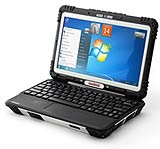 The Handheld Group has introduced the Algiz XRW, and anyone who's been waiting for a fully rugged netbook will welcome this new addition to Handheld's lineup. The XRW, which stands for "Xtreme Road Warrior," runs Windows 7 Ultimate on a 2.0GHz Atom Z550 processor, has 2GB of RAM, a 64GB solid state disk, and has a 10.1-inch daylight-readable 1366 x 768 pixel wide-format display. With IP65 sealing, the footprint of a netbook, and weighing just 3.3 pounds, the Handheld Algiz XRW can go anywhere. [See description and specs of the Handheld Algiz XRW] -- Posted Thursday, September 16, 2010
The Handheld Group has introduced the Algiz XRW, and anyone who's been waiting for a fully rugged netbook will welcome this new addition to Handheld's lineup. The XRW, which stands for "Xtreme Road Warrior," runs Windows 7 Ultimate on a 2.0GHz Atom Z550 processor, has 2GB of RAM, a 64GB solid state disk, and has a 10.1-inch daylight-readable 1366 x 768 pixel wide-format display. With IP65 sealing, the footprint of a netbook, and weighing just 3.3 pounds, the Handheld Algiz XRW can go anywhere. [See description and specs of the Handheld Algiz XRW] -- Posted Thursday, September 16, 2010
1080p HD video everywhere: Microsoft's new LifeCam
All of a sudden 1080p HD video is everywhere, and very affordably so. Microsoft just introduced a new addition to its LifeCam series with the LifeCam Studio that can do true 16-9 aspect ratio 1080p video. The cam will be available for an estimated retail price of US$99.95 at BestBuy. [See LifeCam Studio product page] -- Posted Wednesday, September 15, 2010
Motorola releases new healthcare-oriented rugged handheld
 Motorola released the MC75A0-HC enterprise digital assistant, a device designed for use in healthcare organizations and other medical settings. Based on the popular MC75A, the new healthcare version can handle the cleaning agents used in disinfecting gear in clinical settings, and it fits in with a blue/white color scheme. Based on the 806MHz Marvel PXA320 and running Windows Mobile 6.5, the MC75A0-HC is designed to help improve patient safety and worker efficiency in any healthcare setting. [See description and specs of the Motorola MC75A0-HC] -- Posted Wednesday, September 15, 2010
Motorola released the MC75A0-HC enterprise digital assistant, a device designed for use in healthcare organizations and other medical settings. Based on the popular MC75A, the new healthcare version can handle the cleaning agents used in disinfecting gear in clinical settings, and it fits in with a blue/white color scheme. Based on the 806MHz Marvel PXA320 and running Windows Mobile 6.5, the MC75A0-HC is designed to help improve patient safety and worker efficiency in any healthcare setting. [See description and specs of the Motorola MC75A0-HC] -- Posted Wednesday, September 15, 2010
N-trig DuoSense (pen & multi-touch)
Digitizer maker N-trig took the "back-to-school" season as an opportunity to issue a press release on the many uses of its innovative DuoSense technology that combines digital pen functionality with multi-touch. DuoSense is currently used in various HP, Dell and Lenovo products and is a competitor to Wacom's G6 Multi-Touch technology used in the Motion J3500 tablet. -- Posted Wednesday, September 15, 2010
Nokia's hires Microsoft exec as new CEO
While Nokia remains the world's #1 cellphone maker, it has essentially no presence in the smartphone market, and that is where things are going. Given that Apple and Android pretty much have a stranglehold on that market, what can Nokia do? Apparently hire the prez of Microsoft's Business Division, the folks who handle Microsoft Office and server products, as its new CEO. Best of luck to Stephen Elop as he's tackling a very tough job. -- Posted Tuesday, September 14, 2010
Is the world ready for a tablet with dual 14-inch screens?
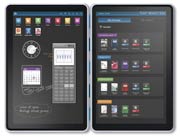 Most current and planned tablets have 7 or 10-inch screens. The Kno, which stands fro "Knowledge Now," is much larger than that--it consists of not one but two massive 14.1-inch screens. That's because the Kno, which uses a pen, is designed to be a digital textbook, with the size of a textbook and the ability to display two full pages at once. TechCrunch reports that none other than Netscape founder Marc Andreessen has invested in Kno and considers it the "most powerful tablet anyone has ever made." Kno claims "revolutionary digital note-taking using natural handwriting" and is supposed to cost under US$1,000. [Check Kno website] -- Posted Tuesday, September 14, 2010
Most current and planned tablets have 7 or 10-inch screens. The Kno, which stands fro "Knowledge Now," is much larger than that--it consists of not one but two massive 14.1-inch screens. That's because the Kno, which uses a pen, is designed to be a digital textbook, with the size of a textbook and the ability to display two full pages at once. TechCrunch reports that none other than Netscape founder Marc Andreessen has invested in Kno and considers it the "most powerful tablet anyone has ever made." Kno claims "revolutionary digital note-taking using natural handwriting" and is supposed to cost under US$1,000. [Check Kno website] -- Posted Tuesday, September 14, 2010
Don't look for AMD in tablets anytime soon
It's unclear for now what processor will dominate in the upcoming generation of Android, WebOS and possibly Microsoft-based iPad competitors, but it likely won't be AMD. In an interview at InsideHW, an AMD VP essentially said that a company with just 15% market share is best served by going after the markets they're already in, and perhaps in high-volume markets like netbooks. Tablets, however, will first have to prove themselves before AMD gets involved. [See InsideHW interview] -- Posted Tuesday, September 14, 2010
Android form factor issues
Just like Windows CE before it, the Android OS is having problems accommodating devices with different screen sizes and resolutions. As is, Android was really designed for small, portrait-oriented smartphone displays and accommodating landscape-oriented tablet displays isn't without problems. The latest 2.2 version of Android, for example, is not optimized for tablets, something Google itself freely admits. Apple is facing the same issue with the iPhone and iPad where there are different OS versions and iPad apps are increasingly higher-end and higher priced. -- Posted Tuesday, September 14, 2010
Full review: Trimble Yuma rugged tablet
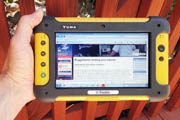 The Trimble Yuma is a very rugged, small and light (2.6 pounds) tablet computer that can go places where a full-size tablet is just too large and heavy. The Yuma is Atom-powered, has an exceptionally bright outdoor-viewable touch screen display, and is dust and waterproof. In RuggedPCReview's testing, the Yuma proved to be a very trust-inspiring, easy-to-use, and exceptionally sturdy machine. Running Windows 7 and having good onboard connectivity, including two cameras and GPS, make the Yuma suitable for a large variety of field applications. [See full review of the Trimble Yuma] -- Posted Tuesday, September 7, 2010
The Trimble Yuma is a very rugged, small and light (2.6 pounds) tablet computer that can go places where a full-size tablet is just too large and heavy. The Yuma is Atom-powered, has an exceptionally bright outdoor-viewable touch screen display, and is dust and waterproof. In RuggedPCReview's testing, the Yuma proved to be a very trust-inspiring, easy-to-use, and exceptionally sturdy machine. Running Windows 7 and having good onboard connectivity, including two cameras and GPS, make the Yuma suitable for a large variety of field applications. [See full review of the Trimble Yuma] -- Posted Tuesday, September 7, 2010
Getac introduces Intel i7-powered V200 rugged convertible notebook with super-bright 12.1-inch multi-touch display
 Getac announced the V200 rugged convertible notebook computer, which represents a more powerful, higher-end addition to the company's V100 that remains available. The V200 is based on a 2GHz Intel Core i7-620LM processor, has a 12.1-inch 1280 x 800 pixel display with a superbright 1,200 nits backlight, resistive multi-touch that works while wearing gloves, a forward/backward facing 2mp camera, available "LifeSupport" hot-swappable battery technology, GPS, Gobi 2000, a variety of keyboard options, and, of course, the highly configurable convertible design that allows operation both as a notebook and as a tablet. [See description and specs of the Getac V200] -- Posted Tuesday, September 7, 2010
Getac announced the V200 rugged convertible notebook computer, which represents a more powerful, higher-end addition to the company's V100 that remains available. The V200 is based on a 2GHz Intel Core i7-620LM processor, has a 12.1-inch 1280 x 800 pixel display with a superbright 1,200 nits backlight, resistive multi-touch that works while wearing gloves, a forward/backward facing 2mp camera, available "LifeSupport" hot-swappable battery technology, GPS, Gobi 2000, a variety of keyboard options, and, of course, the highly configurable convertible design that allows operation both as a notebook and as a tablet. [See description and specs of the Getac V200] -- Posted Tuesday, September 7, 2010
Fujitsu announces 10-inch Intel Core i5-powered multi-touch Lifebook T580 convertible
Fujitsu announced the Lifebook T580, a small 3.1-lbs computer that at first sight looks like a netbook with its compact body and 10-inch display. However, the T580 packs far more power and many more features than your standard netbook. Most notably, it's powered by an Intel Core i5 processor and it offers multi-touch (up to four fingers) capabilities. 3G wireless and GPS are options, and the dual-input digitizer reportedly uses the N-trig DuoSense system, though we do not have that confirmed yet. For a demo of the T580, check this YouTube demonstration. -- Posted Sunday, September 5, 2010
Full review: Panasonic Toughbook 31
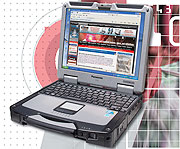 Panasonic's flagship Toughbook hardly needs an introduction. Few computers have the history and pedigree of the rugged Toughbooks that hold a special place as perhaps the most popular rugged notebook computers ever made. In mid-2010, Panasonic announced the Toughbook 31 with a variety of technology updates (including Intel Core i3 and i5 processors) and enhancements that brings the platform technologically up-to-date without obsoleting existing customers' investment in older Toughbook docks and peripherals. [Read full review of the Panasonic Toughbook 31] -- Posted Thursday, September 2, 2010
Panasonic's flagship Toughbook hardly needs an introduction. Few computers have the history and pedigree of the rugged Toughbooks that hold a special place as perhaps the most popular rugged notebook computers ever made. In mid-2010, Panasonic announced the Toughbook 31 with a variety of technology updates (including Intel Core i3 and i5 processors) and enhancements that brings the platform technologically up-to-date without obsoleting existing customers' investment in older Toughbook docks and peripherals. [Read full review of the Panasonic Toughbook 31] -- Posted Thursday, September 2, 2010
Neonode zForce optical touch screen in new Sony readers!
Neonode and Sony announced that Neonode's zForce touch screen technology that uses a grid of infrared beams to determine the location of your finger is used in Sony's new line of Readers. The new Sonys. including the new US$179 Reader Pocket Edition, US$229 Reader Touch Edition and, in the US, the US$299 wireless Reader Daily Edition. Sony calls zForce a "new, first-to-market technology [that] enhances ease of use and increases reading clarity" though Neonode itself had used zForce in its earlier N1 and N2 phones. zForce supports touch and high res pen input, multi-touch, gestures like zooming, offers superior picture quality since there is no overlay, and also reduces power consumption. [See Neonode press release and Sony press release] -- Posted Wednesday, September 1, 2010
 If you feel iPhones and such are nice, but not quite rugged enough and they don't really fit into your corporate enterprise systems, Intermec has a device for you. It's the new CS40 that's small and handy enough to fit into any pocket, has an industrial-strength 1D/2D scanning engine, 3.75G WWAN, a QWERTY or a phone key layout, Windows Mobile 6.5, and the kind of ruggedness and longevity that consumer phones just can't match. [See description and specs of the Intermec CS40] -- Posted Wednesday, September 29, 2010
If you feel iPhones and such are nice, but not quite rugged enough and they don't really fit into your corporate enterprise systems, Intermec has a device for you. It's the new CS40 that's small and handy enough to fit into any pocket, has an industrial-strength 1D/2D scanning engine, 3.75G WWAN, a QWERTY or a phone key layout, Windows Mobile 6.5, and the kind of ruggedness and longevity that consumer phones just can't match. [See description and specs of the Intermec CS40] -- Posted Wednesday, September 29, 2010 For a while now Psion-Teklogix has been concerned about offering their customers the exact right handheld computer for a given job. This resulted in the "Modulus" concept that modularizes their hardware platforms as much as possible. With their new full-size Omni XT10, the company is now offering a fully modular ultra-rugged handheld that adheres to the stated goal of offering flexibility, modularity and an open platform to their customers. [See description and specs of the Psion Teklogix Omnii XT10] -- Posted Thursday, September 30, 2010
For a while now Psion-Teklogix has been concerned about offering their customers the exact right handheld computer for a given job. This resulted in the "Modulus" concept that modularizes their hardware platforms as much as possible. With their new full-size Omni XT10, the company is now offering a fully modular ultra-rugged handheld that adheres to the stated goal of offering flexibility, modularity and an open platform to their customers. [See description and specs of the Psion Teklogix Omnii XT10] -- Posted Thursday, September 30, 2010 Motorola released the MC65 enterprise digital assistant. It's an ultra-rugged (6-foot drop, IP65 sealing) handheld that combines advanced data capture via a Symbol SE4500 1D/2D imager, PDA functionality, with software-configurable dual 3.5G GSM HSPA and CDMA EVDO Rev A WWAN. This means the device can use virtually any carrier anywhere. Also new compared to the MC55: full VGA display, USB 2.0, larger battery, and more internal storage. [See description and specs of the
Motorola released the MC65 enterprise digital assistant. It's an ultra-rugged (6-foot drop, IP65 sealing) handheld that combines advanced data capture via a Symbol SE4500 1D/2D imager, PDA functionality, with software-configurable dual 3.5G GSM HSPA and CDMA EVDO Rev A WWAN. This means the device can use virtually any carrier anywhere. Also new compared to the MC55: full VGA display, USB 2.0, larger battery, and more internal storage. [See description and specs of the  The
The  Motorola released the MC75A0-HC enterprise digital assistant, a device designed for use in healthcare organizations and other medical settings. Based on the popular MC75A, the new healthcare version can handle the cleaning agents used in disinfecting gear in clinical settings, and it fits in with a blue/white color scheme. Based on the 806MHz Marvel PXA320 and running Windows Mobile 6.5, the MC75A0-HC is designed to help improve patient safety and worker efficiency in any healthcare setting. [See description and specs of the
Motorola released the MC75A0-HC enterprise digital assistant, a device designed for use in healthcare organizations and other medical settings. Based on the popular MC75A, the new healthcare version can handle the cleaning agents used in disinfecting gear in clinical settings, and it fits in with a blue/white color scheme. Based on the 806MHz Marvel PXA320 and running Windows Mobile 6.5, the MC75A0-HC is designed to help improve patient safety and worker efficiency in any healthcare setting. [See description and specs of the  Most current and planned tablets have 7 or 10-inch screens. The Kno, which stands fro "Knowledge Now," is much larger than that--it consists of not one but two massive 14.1-inch screens. That's because the Kno, which uses a pen, is designed to be a digital textbook, with the size of a textbook and the ability to display two full pages at once. TechCrunch reports that none other than Netscape founder Marc Andreessen has invested in Kno and considers it the "most powerful tablet anyone has ever made." Kno claims "revolutionary digital note-taking using natural handwriting" and is supposed to cost under US$1,000. [
Most current and planned tablets have 7 or 10-inch screens. The Kno, which stands fro "Knowledge Now," is much larger than that--it consists of not one but two massive 14.1-inch screens. That's because the Kno, which uses a pen, is designed to be a digital textbook, with the size of a textbook and the ability to display two full pages at once. TechCrunch reports that none other than Netscape founder Marc Andreessen has invested in Kno and considers it the "most powerful tablet anyone has ever made." Kno claims "revolutionary digital note-taking using natural handwriting" and is supposed to cost under US$1,000. [ The
The 
 Panasonic's flagship Toughbook hardly needs an introduction. Few computers have the history and pedigree of the rugged Toughbooks that hold a special place as perhaps the most popular rugged notebook computers ever made. In mid-2010, Panasonic announced the Toughbook 31 with a variety of technology updates (including Intel Core i3 and i5 processors) and enhancements that brings the platform technologically up-to-date without obsoleting existing customers' investment in older Toughbook docks and peripherals. [Read
Panasonic's flagship Toughbook hardly needs an introduction. Few computers have the history and pedigree of the rugged Toughbooks that hold a special place as perhaps the most popular rugged notebook computers ever made. In mid-2010, Panasonic announced the Toughbook 31 with a variety of technology updates (including Intel Core i3 and i5 processors) and enhancements that brings the platform technologically up-to-date without obsoleting existing customers' investment in older Toughbook docks and peripherals. [Read